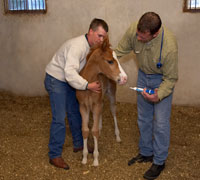 |
| Your veterinarian can help you customize a targeted parasite control plan specific to your foal. Photo courtesy Merck Animal Health |
Depression, nasal discharge, poor growth, diarrhea, colic and possibly even death are all potential consequences of parasitism in foals. After waiting nearly a year for your foal to be born, the last thing you want is to subject him to the harm caused by internal parasites.
Ascarids (roundworms) are the most dangerous parasite to foals. During development, ascarid larvae migrate through the foal’s liver and lungs resulting in fever, cough and nasal discharge. These signs may be mistaken for viral or bacterial respiratory disease. Ascarids complete their development in the foal’s small intestine where large parasite burdens cause diarrhea, impaction colic, peritonitis (inflammation of the stomach lining) and even fatal bowel rupture. Adult ascarids produce large numbers of eggs about 10 to 15 weeks following initial infection. These eggs can survive for 8 to 10 years on pasture.
Ideally, all foals should be treated with a dewormer effective against ascarids at approximately 8 to 12 weeks of age. Depending on stocking density and fecal results, foals may need to be dewormed as often as every 8 to 10 weeks. On some farms, ascarids have become resistant to certain dewormers such as ivermectin. Other dewormers, such as moxidectin, are not labeled for use in foals less than 6 months of age. Fenbendazole and pyrantel remain effective against most ascarids.
Work with your veterinarian to decide when to perform fecal egg counts to monitor for anthelmintic resistance and help determine optimal deworming frequency for your farm.
Other parasites
Due to their immature immune system, foals and weanlings are susceptible to small and large strongyles, pinworms and tapeworms. After weaning, youngsters should be dewormed at regular intervals (typically every 2 to 3 months) with drugs proven effective against small and large strongyles and tapeworms. Your veterinarian can help you customize a targeted parasite control plan specific to your foal, but here are some general recommendations:
| Age | Target parasite(s) | Suggested anthelmintic(s) |
| 60 to 90 days |
| Fenbendazole; oxibendazole; pyrantel; ivermectin |
| 4 to 5 months |
| Pyrantel; ivermectin; fenbendazole (foal dose or larvacidal dose) |
| 6 to 8 months |
| Pyrantel; ivermectin; fenbendazole (foal or larvacidal dose) |
| 8 to 10 months |
| Ivermectin (with or without praziquantel); double-dose pyrantel |
| 12 months and older |
| Ivermectin; moxidectin; fenbendazole; pyrantel |
Dosing for foals
Use a scale or weight tape to determine your foal’s weight. Read the product label carefully for dosing instructions. For example, fenbendazole has two separate dosing regimens for foals:
- 10 mg/kg (PANACUR® foal dose)
- Effective against strongyles, ascarids and pinworms
- 10 mg/kg once daily for 5 days (PANACUR® POWERPAC)
- Increased activity against migrating ascarid and strongyle larvae and encysted small strongyles
Consult your veterinarian
The best resource for all of your foal’s healthcare needs is your veterinarian. To find an equine veterinarian in your area, visit AAEP.org/dvmsearch. To help you track key healthcare milestones for your broodmares and foals through their first birthday, visit FoalCare.com.





